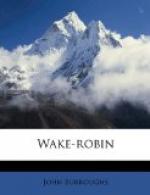But I must leave this part of the subject and hasten on. As to works on ornithology, Audubon’s, though its expense puts it beyond the reach of the mass of readers, is by far the most full and accurate. His drawings surpass all others in accuracy and spirit, while his enthusiasm and devotion to the work he had undertaken have but few parallels in the history of science. His chapter on the wild goose is as good as a poem. One readily overlooks his style, which is often verbose and affected, in consideration of enthusiasm so genuine and purpose so single.
There has never been a keener eye than Audubon’s, though there have been more discriminative ears. Nuttall, for instance is far more happy in his descriptions of the songs and notes of birds, and more to be relied upon. Audubon thinks the song of the Louisiana water-thrush equal to that of the European nightingale, and, as he had heard both birds, one would think was prepared to judge. Yet he has, no doubt, overrated the one and underrated the other. The song of the water-thrush is very brief, compared with the philomel’s, and its quality is brightness and vivacity, while that of the latter bird, if the books are to be credited, is melody and harmony. Again, he says the song of the blue grosbeak resembles the bobolink’s, which it does about as much as the two birds resemble each other in color; one is black and white and the other is blue. The song of the wood-wagtail, he says, consists of a “short succession of simple notes beginning with emphasis and gradually falling.” The truth is, they run up the scale instead of down, beginning low and ending in a shriek.
Yet considering the extent of Audubon’s work, the wonder is the errors are so few. I can at this moment recall but one observation of his, the contrary of which I have proved to be true. In his account of the bobolink he makes a point of the fact that, in returning south in the fall, they do not travel by night as they do when moving north in the spring. In Washington I have heard their calls as they flew over at night for four successive autumns. As he devoted the whole of a long life to the subject, and figured and described over four hundred species, one feels a real triumph on finding in our common woods a bird not described in his work. I have seen but two. Walking in the woods one day in early fall, in the vicinity of West Point, I started up a thrush that was sitting on the ground. It alighted on a branch a few yards off, and looked new to me. I thought I had never before seen so long-legged a thrush. I shot it, and saw that it was a new acquaintance. Its peculiarities were its broad, square tail; the length of its legs, which were three and three quarters inches from the end of the middle toe to the hip-joint; and the deep uniform olive-brown of the upper parts, and the gray of the lower. It proved to be the gray-cheeked thrush, named and first described by Professor Baird. But little seems to be known concerning it, except that it breeds in the far north, even on the shores of the Arctic Ocean. I would go a good way to hear its song.




